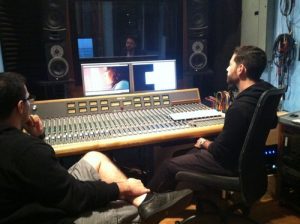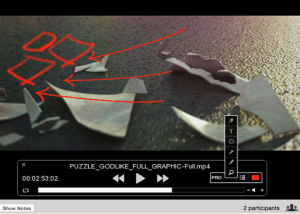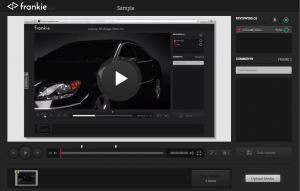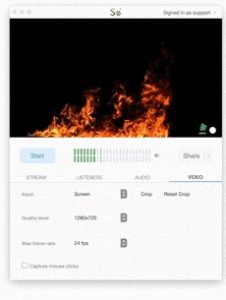Remote Spotting Session Tools
I am a composer living in Los Angeles, CA. To find out more about me you can visit my website at https://www.julianmusicprod.com. I compose music for film, TV, video games, and other visual media. As a composer, my clients may be located anywhere across the globe. In today’s world, long distance collaboration is not uncommon necessitating the need for remote communication. However, even when clients are located in close proximity, the need arises to conduct a spotting session remotely. I’m sure everyone’s heard about LA’s infamous traffic!
Because of this need I wanted to find a tool to help facilitate remote spotting sessions. I’m sure there are other composers and filmmakers who are looking for the same types of tools. So, after doing some research I decided to write a blog post with my findings.
Spotting Session

(picture from https://www.darianharmon.com/)
A spotting session is when a director and composer together watch the film and decide where the music is going to be and what it’s going to do. This occurs before the composer starts writing the music (although the composer may have already started creating concepts for the film). Typically the people present are the director, the composer, the music editor and possibly the producer.
In some manner, the following topics will be discussed for each scene:
- What is the style of music that should be used?
- What is the energy level of the scene?
- What are the emotions the audience should experience?
- Where are the dialogue and sound effects. Not only where they are but where they aren’t.
- What is the contour/shape of the scene? Examples are: Where are the picture cuts? Which picture cuts are important to emphasize with music? Should the emphasis be strong or subtle? Where does the dialogue start/stop? Anything that changes in a scene that needs to be emphasized in some way by the music.
Throughout the session there will be discussions regarding the form of the movie. How does one scene correlate to another scene? Are there characters for which some kind of motif is needed? How does something that happened earlier in the film affect something that happens later?
Good composers will have watched the movie before the spotting session. It is important for the composer to come to a session already prepared to bring well thought out ideas and insights. This leads to a more productive and meaningful exchange between the director and composer.
Exact SMPTE time codes for the entry and exit points of each cue need to be written down. This provides the total number of cues and duration of the score to be written.
Spotting a movie is an art that requires the following:
- Knowledge of story telling in film.
- A solid understanding of the story being told.
- Awareness (on the composer’s part) of directorial and editorial decisions.
- An understanding of what music can bring to a scene.
NOTE: good spotting is not just where the music is present, but where it is absent.
At the conclusion of the session the goals are:
- To be 100% clear on what the director’s goals are for the film.
- To have a vision of what the composer can bring musically to the film.
- For the director and composer to be on the same page.
Remote Spotting Session
Especially in the world of independent film, it is common for the director and composer to be in different locations. Even with the various parties not being co-located a spotting session is still very important. In this case a remote spotting session will need to occur. In a remote spotting session the following things are important:
- All of the people in the spotting session need to watch the film in sync at the same time.
- All parties need to be able to interact with the film.
- All parties need to be able to write notes and markup at specific points in the film.
- All of the notes and markup captured during the session need to be able to be distributed to everyone once the session is over.
In essence, it is essential to have a live interactive synchronized film viewing session with good note-taking and markup tools.
So, what tools exist that meet this criteria?
Tools
Again, my basic criteria is a tool that offers the ability to hold live interactive synchronized film viewing sessions with good note-taking and markup tools.
To hold a remote spotting session you could do something as simple has setup a Google Hangout using screen sharing so that all participants can watch the film. This is a very low cost option that works. However, it lacks the ability for each participant to interact with the film and doesn’t have good note-taking and markup tools.
I wanted to search for other options that would provide a better more professional experience understanding that there would be cost involved.
I took a look at the following five tools:
After reading the online documentation, Wipster and Frame.io were taken off my list because they didn’t appear to offer live interactive sessions. For the remainder of this blog, I will provide my assessment of the other three tools I assessed.
Comparison Chart
This comparison chart compares the lowest priced options of each product offering.
| cineSync | Frankie | Source Live | |
| Starting Price | $99/mo or $499/yr | $49/mo | $395 |
| Subscription Option | Yes | Yes | Yes |
| One-Time Purchase Option | No | No | Yes |
| Free Trial | Yes – 7 days | Yes – 30 days | Yes – 15 days |
| Interactive by All | Yes | Yes | No |
| Commenting w/o Sign Up | Yes | Yes | No |
| Live Share | Yes | Yes | Yes |
| Note Taking | Yes | Yes | No |
| Annotations | Yes | Yes | No |
| Exporting Comments | Yes | No | No |
| Browser App | No | Yes | No |
| Native Mobile App | Yes | No | Yes |
| Native OS App | Yes | No | Yes |
| Secure Share | Yes | No | No |
| DAW Integration | No | No | Yes |
cineSync

(picture from https://cospective.com/cinesync/)
cineSync is a tool provided by Cospective. This tool targets larger production companies making feature films. For these types of companies security is of the utmost importance. The premise of cineSync is that each party involved in the review has the video(s) locally stored. Cospective integrates with Aspera, so if you have an Aspera server you can initiate a file transfer directly from cineSync. Each participating location installs a cineSync application. Only the person/group initiating the review session needs to have a cineSync account. All other participants just need to have the cineSync application installed. Once a session is initiated anyone can interact with the video. Syncing commands like play, pause, go to frame 117, etc are transmitted to Cospective and that data is transmitted to each cineSync application connected to the session. This keeps everyone in sync and the actual video is never transmitted to Cospective. Anyone can type notes and markup in sync. As you type or draw everyone else sees your interaction. After the session all notes and markup can be exported if needed. Once a session is closed it cannot be accessed. The cineSync application runs on Mac, Windows and iOS devices. Of the tools I evaluated, this is the highest priced option. For a standard cineSync account with up to 2 users the cost is $99/mo or $499 for 12 months. Cospective only offers subscription based plans for cineSync.
“cineSync guarantees that you’re always seeing exactly the same frame of exactly the same clip at the same time” – Rory McGregor, CEO of Cospective.
Frankie

Frankie is another interactive review tool provided by Cospective. Per Rory McGregor, CEO of Cospective,
“Frankie really came about as a way of making cineSync-style reviews available to the advertising market.”
The target market for this tool are people and companies that fit the following criteria:
- They don’t have their own infrastructure for media transfers.
- They value simplicity over security.
- They have no IT department on which to rely.
Frankie is a totally browser based solution. The Frankie account holder uploads the video. The video is stored on Cospective cloud based servers (these are actually Amazon cloud servers). Frankie accepts videos in many different formats and converts them all to H.264 format for streaming. The Frankie account holder then initiates a session. They can then share a link with whomever they want to join the session. The plan you select determines how many reviewers can join an interactive session. Whoever receives the link can join the session w/o having a Frankie account. Frankie starts up a page in a browser and within a click or two they now can see the video being shared. All reviewers can interact with the video, write notes and markup. The toolset is not as vast as cineSync but it’s everything a smaller group needs. Similar to cineSync, after a session is over, based on your plan, all the notes and markup can be exported to a PDF. As long as the review is “open”, anyone with the link can access the review either during a live session or on their own time. Because it’s a browser based solution, review participants can use a desktop, laptop, tablet, or mobile device. This is also a subscription based service with a minimum cost of $49/mo. If you’re like me, you aren’t always working on a project so Frankie offers its users the option to pause their account. However, unfortunately, Cospective still charges a fee of $9/mo. Another option is to remove your account and then at the start of your next project create another account. The difference between pausing and removing an account is that a paused account retains all of your reviews and account history. While the removal of an account deletes all of your reviews and history.
NOTE: At the time of this write up, there is a bug in Frankie if you use Chrome. All guests (not the one who initiated the session) who are on Chrome need to click something (anything) in Frankie to let it know you are there and ready to sync. If nothing is clicked, whenever the video is played it won’t play on the guest browser. According to Cospective this was actually introduced by some changes in a Chrome update. Cospective is working on a fix that will be made available soon. Chrome is still their preferred browser.
Source Live

(picture from https://source-elements.com/products/source-live)
Source Live is a tool provided by Source Elements. Source Elements provides a suite of tools and Source Live is the tool that can be used for HD video streaming. According to the Source Elements website, Source Live provides,
“High quality, low latency, encrypted audio and video streaming, in sync from your DAW.”
The target market for Source Live are musicians who want to share/collaborate with others. An ideal scenario for a Composer would be sharing with a Director the cue(s) in your DAW synced to the video so you can get instant feedback.
This is a tool that allows you to stream from your machine to reviewers. They have created a plugin in AAX, VST, AU, and other formats. It works in just about any DAW. You insert the plugin on the bus you want to stream (generally your stereo out bus). You then run a Source Live desktop installed piece of software on your machine and configure it to stream audio from the Source Live plugin. You can also stream audio from other sources. Source Live also provides video streaming. You then invite others to your stream via a link. Once the invitees connect to your stream they can see and hear what you are streaming. So, if you want a reviewer to see the video and hear the cue(s) you are creating to get immediate feedback this tool would meet your needs. What I discovered after setting up a trial is that Source Live is NOT interactive so the invitees can’t interact with the video or type notes or markup. Source Elements offers Source Live via either a subscription or a one-time purchase. They only offer two plans and the one that allows streaming video is either $45/mo or a one-time cost of $995.
My Preferred Tool
Based on my needs and what I valued in a tool, I have chosen to use Frankie for the following reasons:
- I can hold live sessions.
- All participants can interact with the video.
- All participants can write notes and markup.
- All of the notes and markups can be exported.
- It is a very simple tool so my clients don’t have to do anything other than click the link I send them.
- No application is needed to be installed by the initiator or the guest reviewers.
The following are the downsides to using Frankie:
- To initiate a review in Frankie a video must be uploaded. So, if I want to hold a review of work in progress, unlike Source Live I am unable to hold a review of a cue directly from my DAW. Honestly, I’m not sure I would want to do this in the first place but I felt I needed to mention this as a shortcoming.
- As mentioned above, there is currently an annoying bug if using Chrome.
- The cost is high for a small-time individual user.
- Although an account can be paused, there is still a smaller monthly charge.
Reference Links
Reviews and Approvals: Cospective’s Rory McGregor talks cineSync, Frankie
Review of Source Live Pro 3 Live Streaming HD Video and Audio in Sync

This is a great post, thanks for putting it together Julian. I’m actually in your Mus Comp 2 class and found out about this through the chat session. I had an idea that might be useful, Zoom; its more of a meeting tool, but it serves the same purposes and works in browser. The free version might do all that you need, but the basic level is $15/month. I don’t think you would be able to store your video on their server for later use, but you can record the entire meeting along with the original video and archive that way.